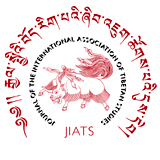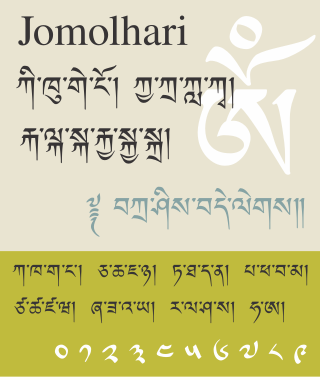Related Research Articles

The Tibetan script is a segmental writing system (abugida) of Indic origin used to write certain Tibetic languages, including Tibetan, Dzongkha, Sikkimese, Ladakhi, Jirel and Balti. It has also been used for some non-Tibetic languages in close cultural contact with Tibet, such as Thakali and Old Turkic. The printed form is called uchen script while the hand-written cursive form used in everyday writing is called umê script. This writing system is used across the Himalayas, and Tibet.

Wylie transliteration is a method for transliterating Tibetan script using only the letters available on a typical English-language typewriter. The system is named for the American scholar Turrell V. Wylie, who created the system and published it in a 1959 Harvard Journal of Asiatic Studies article. It has subsequently become a standard transliteration scheme in Tibetan studies, especially in the United States.
Tise is a Tibetan input method utility for Windows XP, Windows Vista and Windows 7 created by Grigory Mokhin. The name of the program refers to the native name of Mount Kailash in Tibet.
The SASM/GNC/SRC romanization of Tibetan, commonly known as Tibetan pinyin or ZWPY, is the official transcription system for the Lhasa dialect of the Tibetan language for personal names and place names in China. It is based on the pronunciation used by China National Radio's Tibetan Radio, which is based on the pronunciation of the Lhasa dialect, and reflects its pronunciation, except that it does not mark tone. It has been used within China as an alternative to the Wylie transliteration for writing Tibetan in the Latin script since 1982.
The THL Simplified Phonetic Transcription of Standard Tibetan is a system for the phonetic rendering of the Tibetan language.

Lhasa Tibetan, or Standard Tibetan, is the Tibetan dialect spoken by educated people of Lhasa, the capital of the Tibetan Autonomous Region of China. It is an official language of the Tibet Autonomous Region.

The Digital Himalaya project was established in December 2000 by Mark Turin, Alan Macfarlane, Sara Shneiderman, and Sarah Harrison. The project's principal goal is to collect and preserve historical multimedia materials relating to the Himalaya, such as photographs, recordings, and journals, and make those resources available over the internet and offline, on external storage media. The project team have digitized older ethnographic collections and data sets that were deteriorating in their analogue formats, so as to protect them from deterioration and make them available and accessible to originating communities in the Himalayan region and a global community of scholars.
Tibetology refers to the study of things related to Tibet, including its history, religion, language, culture, politics and the collection of Tibetan articles of historical, cultural and religious significance. The last may mean a collection of Tibetan statues, shrines, Buddhist icons and holy scripts, Thangka embroideries, paintings and tapestries, jewellery, masks and other objects of fine Tibetan art and craftsmanship.

Andreas Gruschke was a German author, photographer and Tibet researcher. His scientific background was that of a geographer, Sinologist and ethnologist. He received a 1990 M.A. at Albert-Ludwigs-Universität Freiburg, and a Ph.D. in 2009 at Leipzig University.

The Journal of the International Association of Tibetan Studies (JIATS) ISSN 1550-6363 is a freely available online, peer-reviewed English language academic journal focusing on Tibetan studies. JIATS is an official publication of the International Association of Tibetan Studies (IATS), the association that organizes the world's major academic conference for Tibetan Studies, the results of which are published in the Proceedings of the International Association of Tibetan Studies (PIATS) series.
Tibetan literature generally refers to literature written in the Tibetan language or arising out of Tibetan culture. Historically, Tibetan has served as a trans-regional literary language that has been used, at different times, from Tibet to Mongolia, Russia, and present-day Bhutan, Nepal, India, and Pakistan. Today, the term Tibetan literature can also be applied to any work by an ethnic Tibetan person or arising out of Tibetan folk culture; contemporary Tibetan writers sometimes use Chinese, English, or other languages to compose their work.

Françoise Robin is a Tibetan-studies professor at Paris' National Institute of Oriental Languages and Civilizations (INALCO), where she specialises in the language, cinema, and literature of Tibet. Robin is currently the general secretary of the International Association for Tibetan Studies.

Nyingma Gyubum is a collection of Vajrayana texts reflecting the teachings of the Nyingma ("Ancient") school of Tibetan Buddhism.

Lha Charitable Trust – Institute For Social Work and Education (Lha) is a grassroots, nonprofit organization, and one of the largest Tibetan social work organizations based in Dharamsala, India. It is the first organization that was established in exile to develop a primary focus on Tibetan social work. The Lha Charitable Trust was founded in 1997 and is registered as a charitable trust by the Himachal Pradesh government of India. Lha is managed by Tibetan refugees, is supported by volunteers and contributors from around the world, and serves refugees, the local Indian population and people from the surrounding Himalayan region. In a short period of time, the organization "has grown in leaps and bounds, from a small start-up with two computers to one of largest community based Tibetan NGOs in Dharamsala." Lha is a Tibetan word that means "deity" or "divine."
Kurtis R. Schaeffer is Professor of Tibetan and Buddhist Studies at the University of Virginia and Chair of the Religious Studies department. His primary topics of research are the history of the regions of Nepal, India, Tibet, and China, with a focus on the forms of Buddhism present in these areas, most especially Tibetan Buddhism. Some specific issues he has been concentrated on include Indo-Tibetan poetry, the development of classical learning and printed literature in Tibetan cultural regions, and the history of women, saints, and Dalai Lamas in Tibet. For his work, Schaeffer has received Fulbright, Ryskamp, and Whiting fellowships.

Jomolhari is a Tibetan script Uchen font created by Christopher J. Fynn, freely available under the Open Font License. It supports text encoded using the Unicode Standard and the Chinese national standard for encoding characters of the Tibetan script. The design of the font is based on Bhutanese manuscript examples and it is suitable for text in Tibetan, Dzongkha and other languages written in the Tibetan script. In Latin, it is metrically compatible with Times New Roman.
The Treasury of Lives is an online, open access, peer reviewed, collection of biographical essays, which can be seen as an encyclopedia of historical figures from Tibet, Inner Asia, and the Himalayan Region.

David Francis Germano is an American Tibetologist and Professor of Tibetan and Buddhist Studies at the University of Virginia (UVa), the largest Tibetan Studies program in the Americas, where he has taught and researched since 1992. With dual appointments in the School of Nursing and the Department of Religious Studies, Germano currently oversees the work of over twenty graduate students. He is on the board of the International Association of Tibetan Studies and is Editor-in-Chief of The Journal of the International Association of Tibetan Studies (JIATS), a leading journal of Tibetology. In 2000, he founded the Tibetan and Himalayan Library, a digital initiative for collaborative building of knowledge on the region, which he continues to lead as Director. Since 2008 he has also been the co-director of the UVa Tibet Center. More recently, Germano acted as the founding director of SHANTI at the UVa. Since 2011, Germano has also played a leading role in organizing the University of Virginia's Contemplative Sciences Center, which he currently directs.
The Karchag Lhankarma is a catalog of the Buddhist texts held at the Lhankar palace of the Tibetan Empire. It was probably compiled in 824 CE. It is the only one of the three catalogues of Buddhist texts from the imperial period that is preserved in the Kanjur. It is also the oldest known catalogue of these texts.
References
- ↑ "THDL Public License for Digital Texts". THDL. Archived from the original on 2008-05-14. Retrieved 2008-06-28.